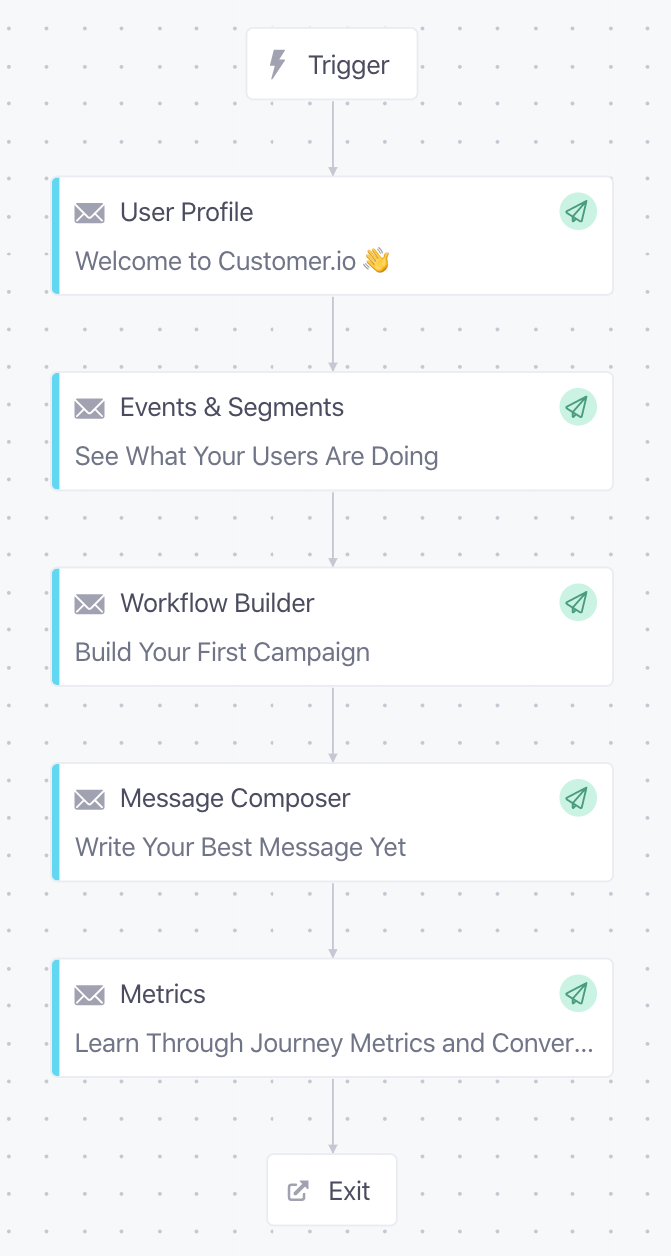Building your first onboarding email campaign with Twilio Segment & Customer.io
Once you’ve started to acquire users, you’ll want to build the perfect onboarding email series for your product. Whether you’re a B2C product or a B2B SaaS platform, a well-thought-out onboarding campaign can play a key role in turning your new users into lifelong customers.
In this guide, you’ll learn how to use Segment and customer.io to create a better product onboarding email series for your product. We’ll touch on the following:
How emails and ad audiences can introduce value to your product.
How to design your first product onboarding campaign.
How to set yourself up to learn and iterate from your first campaign to your ideal campaign.
In many ways, a product onboarding campaign is a re-engagement campaign. There was already a spark that convinced your user to sign up for your product, and a successful onboarding campaign will remind the user why they signed up in the first place.
Targeting your audience with advertising campaigns is an effective way of re-engagement. Utilizing custom ad audiences in Google Ads or Facebook Ads, you can target the exact users who are receiving your product onboarding email series with display ads that match your emails.
In parallel, you’ll stay top-of-mind by reengaging with this audience. Using Customer.io’s Ad Audience Sync, you can keep your segments and ad audiences automatically in sync between Customer.io and your Ad Networks.
What are the steps to unlock the value of your product? If you’re just starting out, it’s likely you won’t have a definitive answer to this question—and that’s okay! You can use a tool like Segment to track those all important first actions.
For our product onboarding campaign, we picked the five most important steps to get up and running in Customer.io.

Your product onboarding email campaign is a great place to test your initial assumptions about your product. Email is a lower cost to produce and quick to update. While you won’t get the same kind of answers as you could with a true A/B test in your product, you can quickly test concepts by including them in your campaign and seeing the response to it.
To start, start by tracking the events (in Segment) that are the most important to find value in your product. For some companies, that might be setting up content preferences (to see personalized results), or setting up domain authentication, or inviting team members.
List the steps, then order them in a way that makes the most sense to progress in your product. When you’re just starting out, we recommend sticking to at most four or five steps—if you listed more than that, you can always A/B test the different steps.
For a B2B product, you often want users to come back into your product to set everything up and uncover the value immediately. We suggest starting with five emails, send one message per day, and schedule the delivery on working days (Mon – Fri).
For B2C, we suggest starting with one email per week for a month to avoid being overkill. If you offer a free trial for your product, then try spacing your emails throughout the free trial. We’ve found this timing works well for a successful strategy.
For those of you who may be struggling to start your campaign, here’s a piece of advice. Your first onboarding campaign won’t be your last; it’s important to get started so you can build the baseline and grow from there. As you build your first product onboarding series, allow yourself to frequently and intentionally iterate from the baseline.
A big part of that set is your tech stack.
At a minimum, you’ll need an email marketing platform (Customer.io). Segment, makes it very easy to quickly set up Customer.io as well as any ad hoc analysis tools (like Google Analytics or Mixpanel), and a data warehouse/ data visualization solution (like Mode Analytics querying Amazon Redshift) with the flip of a switch.
You can use Segment to track all of your users and events to help create the right audiences for your onboarding campaigns in Customer.io. Our recommendation is to start using these tools as early as possible, that way you’ll be amassing data from the start and have a strong baseline of data for your campaigns.
We understand it can be hard identifying what is (or isn’t working) in your first campaign. Open and click-through rates can tell you a little, but it’s more important to follow your users from their first product onboarding email to converting to a customer or tracking their actions with your product.
All that being said, it can take months to collect and analyze this data —and that’s okay. Combine your quantitative data with customer feedback and conduct user interviews. Ask questions about the product onboarding series, and use that feedback to make your email series even better.
Throughout all of this, remember that your first product onboarding email series won’t be your last. You’ll continuously be learning new things about your product and your users. Using the guidelines above, you can take your first steps to build an impactful onboarding campaign.
Are you an early stage startup that would like to use Segment and Customer.io together for free? Click here to apply.
Customer.io is a partner on Segment's Startup Program. You can get 12 months free on their Basic Plan or 90% off their Premium Plan through Segment's Startup Program, or sign up directly for their Startup Program.

Our annual look at how attitudes, preferences, and experiences with personalization have evolved over the past year.